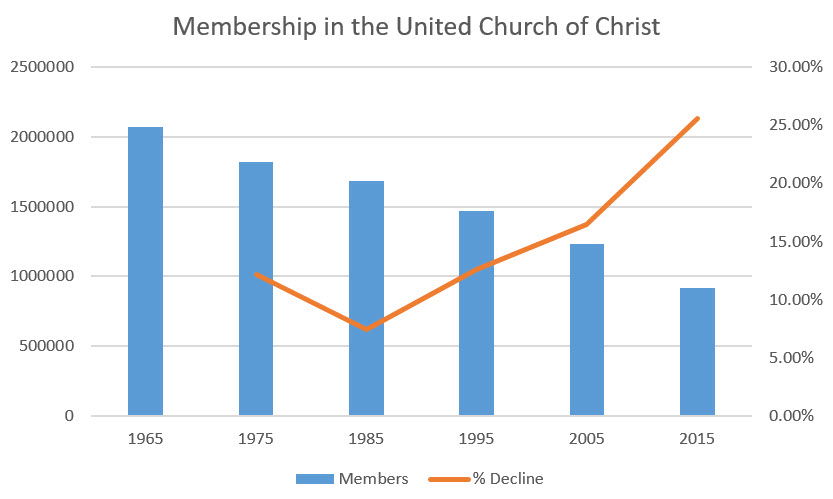 While I consider myself a post-denominational follower of the Way of Jesus, I have spent the most of the last six years involved in the life of congregations affiliated with the United Church of Christ. This Mainline Protestant denomination has experienced a significant decline in membership over the last 50 years from over 2 million members in 1965 to under 1 million members in 2015.
While I consider myself a post-denominational follower of the Way of Jesus, I have spent the most of the last six years involved in the life of congregations affiliated with the United Church of Christ. This Mainline Protestant denomination has experienced a significant decline in membership over the last 50 years from over 2 million members in 1965 to under 1 million members in 2015.
The graph at right shows the denomination’s total membership by year in blue and the percent change or decline from one decade to the next in red. The smallest decline by decade was 7.4% from 1975 to 1985. Since that time the decline has accelerated each decade (membership data as reported in Fall 2016: The United Church of Christ: A Statistical Profile):
- 1985-1995: 12.6%
- 1995-2005: 16.5%
- 2005-2015: 25.6%
Bigger than the UCC
While the statistics presented above are for the United Church of Christ, it is important to note that this Mainline Protestant denomination looks very much like Mainline Protestantism as a whole. For example, data from the General Social Survey shows that those self-identifying as part of one of the denominations that make up Mainline Protestantism declined half over a 40 year period. That research shows roughly 3 out of every 10 Americans in 1972 self-identified as part of one of the Mainline Protestant denominations, but only 1.5 out of every 10 made such a self-identification in 2012.
So What?
I have looked at this data and similar data many times, and participated in many conversations about why it has happened and what it means. Right now, however, I am most interested in the acceleration of decline. In the UCC, over the last three decades compared above the rate started high and grew much higher. More specifically, it grew 3.9% in 1985-1995 to 1995-2005 then more than doubled to 9.1% in 1995-2005 to 2005-2015. If the growth were to double again for 2005-2015 to 2025 it would reach 18% or more for a total decline over a decade of at least 43.6%. And, if this decline occurs, then the United Church of Christ will have a membership of just over half a million in 2025 (516,000).
- What factors do you believe have contributed most significantly to the increased rates of decline over the last 20 years? Which, if any, of these factors is likely to change in a way that would slow decline?
- What, if anything, do you believe can or should be done to try to slow the decline or transition from decline to growth?
Note: There are many practical changes resulting in these shifts. One simple example, is a dramatic increase in the number of congregations with very limited worship attendance. In 2015, nearly half (47.8%) of all UCC congregations have a weekly worship attendance of 1–50 individuals. While these smaller congregations account for the greatest number of churches, they are not where the majority of people place their membership. Only 34.1% of all UCC members belong to a congregation comprised of 200 or fewer members.